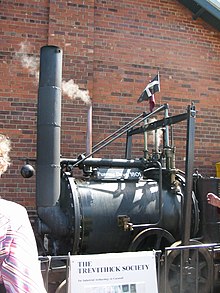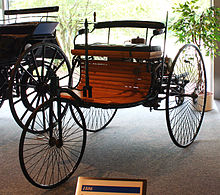The history of the automobile begins as early as 1769, with the creation of steam-powered automobiles capable of human transport. In 1806, the first cars powered by internal combustion engines running on fuel gasappeared, which led to the introduction in 1885 of the ubiquitous moderngasoline- or petrol-fueled internal combustion engine. Cars powered byelectricity briefly appeared at the turn of the 20th century but largely disappeared from commonality until the turn of the 21st century, when interest in low- and zero-emissions transportation was reignited. As such, the early history of the automobile can be divided into a number of eras based on the prevalent method of automotive propulsion during that time. Later periods were defined by trends in exterior styling and size and utility
Pioneer inventors
German engineer Karl Benz, the inventor of numerous car-related technologies, is generally regarded as the inventor of the modern automobile. The four-stroke petrol (gasoline) internal combustion engine that constitutes the most prevalent form of modern automotive propulsion is a creation of German inventor Nikolaus Otto. The similar four-stroke diesel engine was also invented by a German, Rudolf Diesel. The hydrogen fuel cell, one of the technologies hailed as a replacement for gasoline as an energy source for cars, was discovered in principle by yet another German, Christian Friedrich Schönbein, in 1838. The battery electric car owes its beginnings to Hungarian Ányos Jedlik, one of the inventors of the electric motor, and Gaston Planté, who invented the lead-acid battery in 1859.
Steam automobiles
See also: History of steam road vehiclesFerdinand Verbiest, a member of a Jthe first steam-powered vehicle around 1672, designed as a toy for the Chinese Emperor, it being of small scale and unable to carry a driver or passenger but, quite possibly, the first working steam-powered vehicle ('auto-mobile').esuit mission in China, built
Steam-powered self-propelled vehicles are thought to have been devised in the late-18th century. Nicolas-Joseph Cugnot demonstrated his fardier à vapeur, an experimental steam-driven artillery tractor, in 1770 and 1771. Cugnot's design proved to be impractical and his invention was not developed in his native France, the centre of innovation passing to Great Britain. By 1784, William Murdoch had built a working model of a steam carriage in Redruth, and in 1801 Richard Trevithick was running a full-sized vehicle on the road in Camborne. Such vehicles were in vogue for a time, and over the next decades such innovations as hand brakes, multi-speed transmissions, and better steering developed. Some were commercially successful in providing mass transit, until a backlash against these large speedy vehicles resulted in passing a law, the Locomotive Act, in 1865 requiring self-propelled vehicles onpublic roads in the United Kingdom be preceded by a man on foot waving a red flag and blowing ahorn. This effectively killed road auto development in the UK for most of the rest of the 19th century. as inventors and engineers shifted their efforts to improvements in railway locomotives. The law was not repealed until 1896, although the need for the red flag was removed in 1878.
In Russia in the 1780s, Ivan Kulibin started working on a human-pedalled carriage with a steam engine. He finished working on it in 1791. Some of its features included a flywheel, brake, gearbox, and bearing, which are also the features of a modern automobile. His design had threeroadwheels. Unfortunately, as with many of his inventions, the government failed to see the potential market and it was not developed further.
The first automobile patent in the United States was granted to Oliver Evans in 1789. In 1805, Evans demonstrated his first successful self-propelled vehicle, which not only was the first automobile in the USA, but was also the first amphibious vehicle, as his steam-powered vehicle was able to travel on roadwheels on land, and via a paddle wheel in the water.
Among other efforts, in 1815, a professor at Prague Polytechnich, Josef Bozek, built an oil-fired steam car. and Walter Hancock, builder and operator of London steam buses, in 1838 built a four-seat steam phaeton. Steam car development would from them on continue, leading to significant advances by the early 1900s (see Edwardian Era car).
Electric automobiles
See also: History of the electric vehicle
In 1828, Ányos Jedlik, a Hungarian who invented an early type of electric motor, created a tiny model car powered by his new motor. In 1834, Vermont blacksmith Thomas Davenport, the inventor of the first American DC electrical motor, installed his motor in a small model car, which he operated on a short circular electrified track. In 1835, Professor Sibrandus Stratingh of Groningen, the Netherlands and his assistant Christopher Becker created a small-scale electrical car, powered by non-rechargeable primary cells. In 1838, Scotsman Robert Davidson built an electric locomotive that attained a speed of 4 miles per hour (6 km/h). In England, a patent was granted in 1840 for the use of rail tracks as conductors of electric current, and similar American patents were issued to Lilley and Colten in 1847. Between 1832 and 1839 (the exact year is uncertain), Robert Anderson of Scotland invented the first crude electric carriage, powered by non-rechargeableprimary cells.Internal combustion engines
Early attempts at making and using internal combustion engines were hampered by the lack of suitable fuels, particularly liquids, and the earliest engines used gas mixtures.
Early experimenters using gases included, in 1806,Swiss engineer François Isaac de Rivaz who built an internal combustion engine powered by a hydrogen andoxygen mixture, and in 1826, Englishman Samuel Brown who tested his hydrogen-fuelled internal
combustion engine by using it to propel a vehicle upShooter's Hill in south-east London. Belgian-bornEtienne Lenoir's Hippomobile with a hydrogen-gas-fuelled one-cylinder internal combustion engine made a test drive from Paris to Joinville-le-Pont in 1860, covering some nine kilometres in about three hours. A later version was propelled by coal gas. A Delamare-Deboutteville vehicle was patented and trialled in 1884.
About 1870, in Vienna, Austria (then the Austro-Hungarian Empire), inventor Siegfried Marcus put a liquid-fuelled internal combustion engine on a simple handcart which made him the first man to propel a vehicle by means of gasoline. Today, this car is known as "the first Marcus car". In 1883, Marcus secured a German patent for a low-voltage ignition system of the magneto type; this was his only automotive patent. This design was used for all further engines, and the four-seat "second Marcus car" of 1888/89. This ignition, in conjunction with the "rotating-brush carburetor", made the second car's design very innovative.
It is generally acknowledged that the first really practical automobiles with petrol/gasoline-poweredinternal combustion engines were completed almost simultaneously by several German inventorsworking independently: Karl Benz built his first automobile in 1885 in Mannheim. Benz was granted a patent for his automobile on 29 January 1886, and began the first production of automobiles in 1888, after Bertha Benz, his wife, had proved - with the first long-distance trip in August 1888, from Mannheim to Pforzheim and back - that the horseless coach was absolutely suitable for daily use. Since 2008 a Bertha Benz Memorial Route commemorates this event.
Soon after, Gottlieb Daimler and Wilhelm Maybach in Stuttgart in 1889 designed a vehicle from scratch to be an automobile, rather than ahorse-drawn carriage fitted with an engine. They also are usually credited with invention of the first motorcycle in 1886, but Italy's Enrico Bernardi of the University of Padua, in 1882, patented a 0.024 horsepower (17.9 W) 122 cc (7.4 cu in) one-cylinder petrol motor, fitting it into his son's tricycle, making it at least a candidate for the first automobile, and first motorcycle;. Bernardi enlarged the tricycle in 1892 to carry two adults.
One of the first four-wheeled petrol-driven automobiles in Britain was built in Birmingham in 1895 by Frederick William Lanchester, who also patented the disc brake; and the first electric starter was installed on an Arnold, an adaptation of the Benz Velo, built between 1895 and 1898.
In all the turmoil, many early pioneers are nearly forgotten. In 1891, John William Lambert built a three-wheeler in Ohio City, Ohio, which was destroyed in a fire the same year, while Henry Nadig constructed a four-wheeler in Allentown, Pennsylvania. It is likely they were not the only ones.
Vintage era
Main article: Vintage car
The vintage era lasted from the end of World War I (1919), through the Wall Street Crash at the end of 1929. During this period, the front-engined car came to dominate, with closed bodies and standardised controls becoming the norm. In 1919, 90% of cars sold were open; by 1929, 90% were closed. Development of the internal combustion engine continued at a rapid pace, withmulti-valve and overhead camshaft engines produced at the high end, and V8, V12, and even V16 engines conceived for the ultra-rich. Also in 1919, hydraulic brakes were invented by Malcolm Loughead (co-founder of Lockheed); they were adopted by Duesenberg for their 1921 Model A. Three years later, Hermann Rieseler of Vulcan Motor invented the first automatic transmission, which had two-speed planetary gearbox, torque converter, and lockup clutch; it never entered production. (Its like would only become an available option in 1940.) Just at the end of the vintage era, tempered glass (now standard equipment in side windows) was invented in France.
E
xemplary vintage vehicles:
1922–1939 Austin 7 — the Austin Seven was one of the most widely copied vehicles ever, serving as a template for cars around the world, from BMW to Nissan.
1924–1929 Bugatti Type 35 — the Type 35 was one of the most successful racing cars of all time, with over 1,000 victories in five years.
1922–1931 Lancia Lambda — very advanced car for the time, first car to feature a load-bearingmonocoque-type body and independent front suspension.
1925–1928 Hanomag 2 / 10 PS — early example of ponton styling, without fully articulatedfenders and running boards.
1927–1931 Ford Model A (1927-1931) — after keeping the brass era Model T in production for too long, Ford broke from the past by restarting its model series with the 1927 Model A. More than 4 million were produced, making it the best-selling model of the era.
1930 Cadillac V-16 — developed at the height of the vintage era, the V16-powered Cadillac would join Bugatti's Royale as the most legendary ultra-luxury cars of the era.
xemplary vintage vehicles:
1922–1939 Austin 7 — the Austin Seven was one of the most widely copied vehicles ever, serving as a template for cars around the world, from BMW to Nissan.
1924–1929 Bugatti Type 35 — the Type 35 was one of the most successful racing cars of all time, with over 1,000 victories in five years.
1922–1931 Lancia Lambda — very advanced car for the time, first car to feature a load-bearingmonocoque-type body and independent front suspension.
1925–1928 Hanomag 2 / 10 PS — early example of ponton styling, without fully articulatedfenders and running boards.
1927–1931 Ford Model A (1927-1931) — after keeping the brass era Model T in production for too long, Ford broke from the past by restarting its model series with the 1927 Model A. More than 4 million were produced, making it the best-selling model of the era.
1930 Cadillac V-16 — developed at the height of the vintage era, the V16-powered Cadillac would join Bugatti's Royale as the most legendary ultra-luxury cars of the era.







